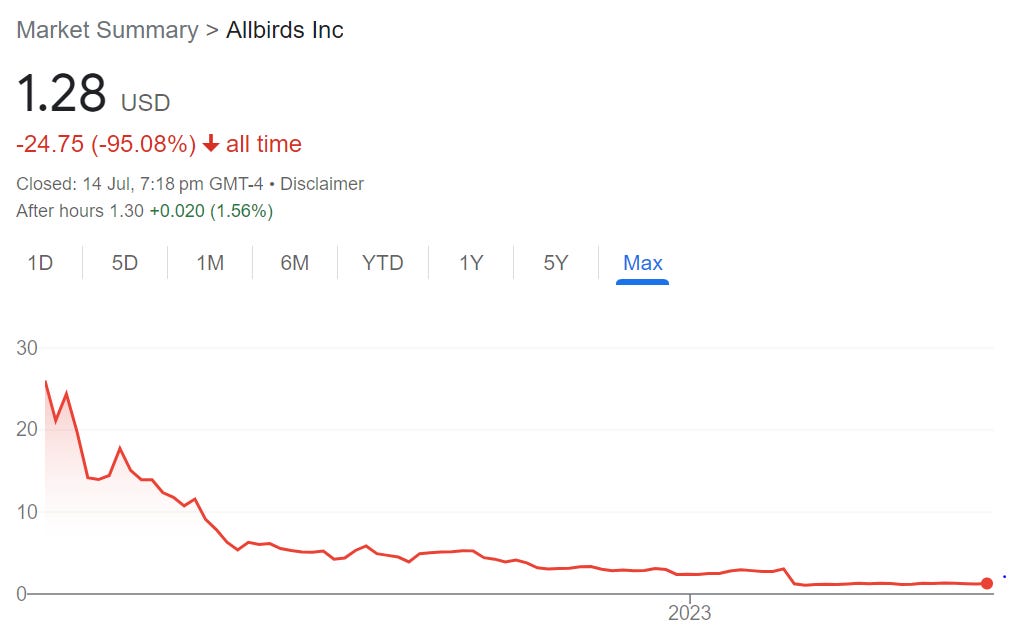Tim Brown (a former professional soccer player) the co-founder of Allbirds had an idea for creating minimalistic shoes from sustainable materials. He saw that he could indeed create shoes from wool and put up the project on kickstarter for validation and to raise funds. The project was fully subscribed and raised $120k on kickstarter.
Soon in 2016, the startup released its Wool Runners shoes which was a big hit. Time Magazine called it ‘the world’s most comfortable shoe’.
The customer value proposition was always around sustainability - that Allbirds products are both comfortable to wear and are good for the environment. Allbirds was able to sell this vision and raise a boatload of money - around 200mn$ in eight rounds.
But ever since Allbirds went public in 2021, the journey has been downhill and the stock is down 95%.
There were two major problems:
1. Footwear is a very competitive category. Building big brands takes a lot of time and a lot of money. Moats are very difficult to build in the category as a new entrant. And broadly defining yourself as ‘environmentally sustainable’ leaves you open to attack from similarly positioned competitors who will try to offer lower prices.
Allbirds in its IPO prospectus in 2021 outlined its moats as follows:
We believe the following four aspects together have created durable competitive moats and resonate deeply with consumers: (1) an authentic, purpose-driven brand that resonates with our stakeholders; (2) innovative and differentiated products propelled by our status as a partner of choice for launching sustainable innovations; (3) a vertical distribution model that enables higher quality at a lower price compared to a traditional wholesale model; and (4) difficult-to-replicate manufacturing know-how. Our target consumers are a vast and rapidly growing segment of the population, which strives to live a more balanced, sustainable lifestyle through an understanding of the impact of their buying habits.
None of these seem to be very durable moats.
2. Allbirds raised a ton of money at a 1.6bn$ valuation. Raising that much money forces you to expand your product offerings to more shoes and shoe types and to other adjacent categories like apparel.
But here is the problem - while the Wool Runners shoes were a verifiable hit with customers, Allbirds found it difficult to extend this success to other offerings. Even in its IPO prospectus in 2021, five years after the launch of Wool Runners, Allbirds calls it its ‘most iconic product’. Even creating more well functioning products out of ‘sustainable’ materials was unproven and proved to be very difficult.
The Wall Street Journal recently has a detailed news story on problems at Allbirds. It details the company’s shortcomings in expanding to more products and targeting a different set of customers.
It turns out that not everyone wants to dress head-to-toe in merino wool, which although better for the environment than nylon or polyester, isn’t as durable. Customers complained of holes in their sneakers months after buying them. And the leggings, which were made from a blend of wool and other fibers, in addition to being see-through, didn’t hold their shape, the people said. Allbirds said the sheerness was limited to one light color and that it was a minor issue caught at an early stage.
After the initial success of its original shoe, the Wool Runner, Allbirds tried to expand beyond its base of 30- and 40-year-olds to attract younger customers with more technical running shoes and other sneakers in brighter colors and edgier patterns. It also pushed into new categories—underwear, puffer jackets and golf shoes—but struggled to replicate the success of its first shoe.
Edward Yruma, a senior research analyst at Piper Sandler who follows Allbirds, took a photograph of himself last year after a run in one of the T-shirts and sent it to company executives. “It was so wet it looked like I had taken a shower with the shirt on,” Yruma said.
The company has also been trying to build performance shoes made from ‘sustainable materials’ but the customer expectations from performance shoes are different than ‘sustainable and comfortable’.
Allbirds launched its second sneaker in 2020, the Tree Dasher, made of eucalyptus tree fiber. It marketed it as an entry-level running shoe, pitting it against industry giants Nike, Adidas and others. It pushed further into the running business two years later with the Tree Flyer.
Sales of the Flyer were disappointing, according to the company. Some customers said it lacked the support and cushioning needed for hard-core running. It was also more expensive, priced at $160, compared with $95 for the Wool Runner when it launched.
“Consumers weren’t ready to shell out $160 for a technical running performance product from us, given that’s not the ethos [of our] DNA,” Zwillinger told analysts in March.
The Pacer, a sneaker made of vegan leather that was introduced in 2022, didn’t live up to expectations. Other types of apparel that Allbirds introduced such as $250 puffer jackets and $88 dresses, also made from merino wool, didn’t attract customers and had to be discounted. The company has since discontinued its leggings and other performance clothing and liquidated unsold apparel at a cost of roughly $13 million.
Full read here
Businesses have an internal tendency to overestimate the strength of a brand’s positioning. A set of customers would probably be delighted with ‘sustainable’ products but will weigh price, comfort, performance and other parameters too when making a decision. Allbirds (and its private investors) also seem to have underestimated the difficulty of expanding to newer categories and even the difficulty of creating more products from sustainable materials.






